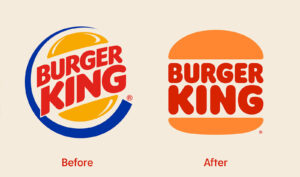 It’s safe to say that many people are all trying to rebrand themselves after 2020, one of the most challenging years in recent memory. It is no surprise that Burger King is jumping in on the ‘new year, new me’ bandwagon. The company made waves with popular branding strategies in the past– it previously made it possible to “smell like a Whopper,” it released a Whopper air-freshener, it served black burger buns for Halloween, and it even released an absurd yule log sweater for Christmas. Now, the food giant has announced a fresh new logo to kick off the New Year. The fast food chain recently announced it would be rebranding after retiring its current logo of over 20 years. The new logo has a retro style, paying homage to BK’s branding used from 1969-1999, as it aims to “seamlessly meet the brand evolution of the times.” The logo stars a new custom-made font, appropriately titled “Flame.” It is inspired by the rounded and bold shapes of the chain’s signature food. The design has been welcomed as a return to Burger King’s origins while revamping the company’s visual identity.
It’s safe to say that many people are all trying to rebrand themselves after 2020, one of the most challenging years in recent memory. It is no surprise that Burger King is jumping in on the ‘new year, new me’ bandwagon. The company made waves with popular branding strategies in the past– it previously made it possible to “smell like a Whopper,” it released a Whopper air-freshener, it served black burger buns for Halloween, and it even released an absurd yule log sweater for Christmas. Now, the food giant has announced a fresh new logo to kick off the New Year. The fast food chain recently announced it would be rebranding after retiring its current logo of over 20 years. The new logo has a retro style, paying homage to BK’s branding used from 1969-1999, as it aims to “seamlessly meet the brand evolution of the times.” The logo stars a new custom-made font, appropriately titled “Flame.” It is inspired by the rounded and bold shapes of the chain’s signature food. The design has been welcomed as a return to Burger King’s origins while revamping the company’s visual identity.

You too can smell flame-grilled!
Many people wonder what happens behind the scenes of a company’s branding transition, especially business owners looking to do the same. The process may include one of two possible routes: (1) trademark registration or (2) amendment of a currently registered trademark. Either option allows for a quick refresh or rebranding of a logo. However, the requesting party should ensure that it is choosing the best option for its needs. If the current logo is not “materially altered,” an amendment to trademark registration of the company’s logo should suffice to protect the company’s branding for trademark purposes. If, on the other hand, a company is making more than just a simple facelift to the currently registered logo, the best option to ensure protection may be to file a new trademark application with the United States Patent and Trademark Office (USPTO). Additionally, companies should be mindful of third parties to whom they may have previously licensed logos. An amendment to, or new registration of, a company’s logo means that current licenses to third parties will be revoked, and a new license may need to be executed. Furthermore, the new logo’s distinctive elements (like BK’s Flame font), may be entitled to additional intellectual property protection, such as copyright.
Although rebranding can be beneficial for a company’s ambitious strategy to create a new visual identity and embrace an appealing philosophy, practical matters are just as important when it comes to trademarks. Failing to comply with USPTO requirements could leave a company vulnerable to costly litigation or the need to amend its logo, if it is unable to register its new logo in time to prevent other parties from using it. The USPTO uses specific criteria when considering trademark applications. To increase your chances of success, you should always consult a legal professional with experience in trademarks. At Amineddoleh & Associates LLC, our team has years of practice prosecuting trademark applications and working with clients to actively protect their intellectual property.